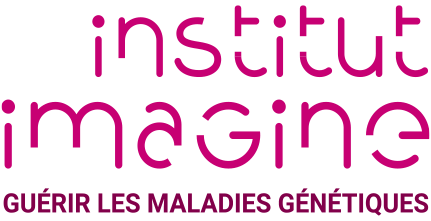Published on 22.10.2025
Presentation
Head of Department : Pr. Nathalie Boddaert
Brain magnetic resonance imaging (MRI) is a non-invasive neuroimaging technique that allows to visualize brain anatomy and function in vivo.
For the last 10 years, using a 3 Tesla scanner (General Electric), our team has worked on advanced multimodal neuroimaging sequences at the pediatric radiology department of the Necker-Enfants Malades hospital.
These brain MRI sequences can be used to measure cerebral blood flow at rest with perfusion sequences using arterial spin labeling (ASL), visualize and analyze with high resolution brain anatomical structure and brain changes using structural sequences (3D T1-weighted, T2-weighted, Cube T1, Cube T2, T2 FLAIR), visualize and analyze white matter pathways using diffusion tensor imaging (DTI), measure synaptic activity at rest, during a particular task or combined with electroencephalography to localize the brain activity (respectively rsfMRI, task-fMRI or EEG-rsfMRI).
These multimodal imaging sequences allow comparisons between groups or populations, in order to further understand the physiopathology of certain diseases, as well as longitudinal measurements to investigate the evolution of these parameters in a pathological context. Finally, ongoing investigations could help develop brain imaging biomarkers in different disorders.
More information on the page of the associated research team Image@Imagine.
Team
Resources & publications
-
 2025Journal (source)J Neuroradiol
2025Journal (source)J NeuroradiolIntraoperative and Long-Term Multimodal Radiological Assessment of Brain MR-g...
-
 2023Journal (source)Eur Radiol
2023Journal (source)Eur RadiolThe longitudinal evolution of cerebral blood flow in children with tuberous s...
-
 2023Journal (source)Front Neurosci
2023Journal (source)Front NeurosciCase Report: Zolpidem's paradoxical restorative action: A case report of func...
-
 2022Journal (source)Neurosurgery
2022Journal (source)NeurosurgeryPreoperative Detection of Subtle Focal Cortical Dysplasia in Children by Comb...
-
 2024Journal (source)Cereb Cortex
2024Journal (source)Cereb CortexIdentifying interindividual variability of social perception and associated b...
-
 Journal (source)J Med Genet
Journal (source)J Med Genet
.High predictive value of brain MRI imaging in primary mitochondrial respirato...
-
 Journal (source)Clin Neuroradiol
Journal (source)Clin Neuroradiol
.Arterial Spin Labeling and Central Precocious Puberty
-
 Journal (source)AJNR Am J Neuroradiol.
Journal (source)AJNR Am J Neuroradiol.Focal Areas of High Signal Intensity in Children with Neurofibromatosis Type ...
-
 Journal (source)Lancet Child Adolesc Health.
Journal (source)Lancet Child Adolesc Health.Neuroimaging manifestations in children with SARS-CoV-2 infection: a multinat...
-
 Journal (source)Dev Med Child Neurol.
Journal (source)Dev Med Child Neurol.Cerebral blood flow and acute episodes of Leigh syndrome in neurometabolic di...
-
 Journal (source)AJNR Am J Neuroradiol
Journal (source)AJNR Am J NeuroradiolArterial Spin-Labeling in Children with Brain Tumor: A Meta-Analysis
-
 Journal (source)Transl Psychiatry
Journal (source)Transl PsychiatryNeuroimaging evidence of brain abnormalities in mastocytosis
-
 Journal (source)Neuro Oncol.
Journal (source)Neuro Oncol.Cerebral blood flow changes after radiation therapy identifies pseudoprogress...
-
 Journal (source)AJNR Am J Neuroradiol.
Journal (source)AJNR Am J Neuroradiol.CT and Multimodal MR Imaging Features of Embryonal Tumors with Multilayered R...
-
 Journal (source)Eur Radiol.
Journal (source)Eur Radiol.Radiogenomics of diffuse intrinsic pontine gliomas (DIPGs): correlation of hi...
-
 Journal (source)Acta Neuropathol
Journal (source)Acta Neuropathol
.Clinicopathological and molecular characterization of three cases classified ...
-
 Journal (source)Dev Med Child Neurol
Journal (source)Dev Med Child Neurol
.Early magnetic resonance imaging to detect presymptomatic leptomeningeal angi...
-
 2023Journal (source)Neuropediatrics
2023Journal (source)NeuropediatricsAbnormal Spontaneous Blood Oxygenation Level Dependent Fluctuations in Childr...
-
 2022Journal (source)AJNR Am J Neuroradiol
2022Journal (source)AJNR Am J NeuroradiolArterial Spin-Labeling Perfusion Imaging in the Early Stage of Sturge-Weber S...
-
 2022Journal (source)Brain Commun.
2022Journal (source)Brain Commun.Periodic electroencephalographic discharges and epileptic spasms involve cort...
-
 Journal (source)J Cereb Blood Flow Metab
Journal (source)J Cereb Blood Flow MetabA CBF decrease in the left supplementary motor areas: New insight into postop...
-
 2021Journal (source)J Neurosurg Pediatr
2021Journal (source)J Neurosurg PediatrMortality and functional outcome after pediatric intracerebral hemorrhage: co...
-
 2020Journal (source)Epilepsia Open
2020Journal (source)Epilepsia OpenComplete hemispherotomy leads to lateralized functional organization and lowe...
-
 2020Journal (source)Neuroimage Clin
2020Journal (source)Neuroimage ClinArterial spin labeling brain MRI study to evaluate the impact of deafness on ...
-
 2020Journal (source)Cereb Cortex
2020Journal (source)Cereb CortexRest Functional Brain Maturation during the First Year of Life.
-
 2019Journal (source)Sci Rep
2019Journal (source)Sci RepNeural and behavioral signature of human social perception.
-
 2020Journal (source)Sci Rep
2020Journal (source)Sci RepNeural basis of interindividual variability in social perception in typically...
-
 2019Journal (source)Neuro-oncology
2019Journal (source)Neuro-oncologyCerebral blood flow changes after radiation therapy identifies pseudoprogress...
-
 2017Journal (source)Cereb. Cortex
2017Journal (source)Cereb. CortexTuning Eye-Gaze Perception by Transitory STS Inhibition.
-
 2020Journal (source)J. Inherit. Metab. Dis.
2020Journal (source)J. Inherit. Metab. Dis.Central nervous system complications in adult cystinosis patients.
-
 2020Journal (source)Cerebellum
2020Journal (source)CerebellumPosterior Fossa Arachnoid Cyst in a Pediatric Population is Associated with S...
-
 2019Journal (source)Neuroimage Clin
2019Journal (source)Neuroimage ClinAnatomical and functional abnormalities on MRI in kabuki syndrome.
-
 2020Journal (source)Mol Autism
2020Journal (source)Mol AutismImpact of on-site clinical genetics consultations on diagnostic rate in child...




